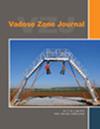Examining the value of hydropedological information on hydrological modeling at different scales in the Sabie catchment, South Africa
IF 2.8
3区 地球科学
Q3 ENVIRONMENTAL SCIENCES
引用次数: 0
Abstract
Abstract Detailed soil information is increasingly sought after for watershed‐scale hydrological modeling to better understand the soil–water interactions at a landscape level. In South Africa, 8% of the surface area is responsible for 50% of the mean annual runoff. Thus, understanding the soil–water dynamics in these catchments remains imperative to future water resource management. In this study, the value of hydropedological information is tested by comparing a detailed hydropedological map based on infield soil information to the best readily available soil information at five different catchment sizes (48, 56, 174, 674, and 2421 km 2 ) using the soil and water assessment tool (SWAT)+ model in the Sabie catchment, South Africa. The aim was to determine the value of hydropedological information at different scales as well as illustrate the value of hydropedology as soft data to improve hydrological process representation. Improved hydropedological information significantly improved long‐term streamflow simulations at all catchment sizes, except for the largest catchment (2421 km 2 ). It is assumed that the resulting improved streamflow simulations are a direct result of the improved hydrological process representation achieved by the hydropedological information. Here, we argue that hydropedological information should form an important soft data tool to better understand and simulate different hydrological processes.考察南非萨比流域不同尺度水文模型的水文水文信息的价值
为了更好地理解景观水平上的土壤-水相互作用,流域尺度水文建模越来越需要详细的土壤信息。在南非,8%的地表面积产生了50%的年平均径流量。因此,了解这些流域的土壤-水动力学对未来的水资源管理仍然是必不可少的。在这项研究中,通过将基于内场土壤信息的详细水文土壤图与最容易获得的土壤信息进行比较,利用土壤和水评估工具(SWAT)+模型,在南非Sabie流域进行了5个不同流域(48、56、174、674和2421 km2)的水文土壤信息的价值。目的是确定不同尺度水文水文信息的价值,并说明水文水文作为软数据的价值,以改善水文过程的表征。改善的水文水文信息显著改善了所有流域的长期流量模拟,除了最大的流域(2421 km2)。假设由此得到的改进的水流模拟是由水文水文信息实现的改进的水文过程表示的直接结果。在这里,我们认为水文信息应该成为一个重要的软数据工具,以更好地理解和模拟不同的水文过程。
本文章由计算机程序翻译,如有差异,请以英文原文为准。
求助全文
约1分钟内获得全文
求助全文
来源期刊

Vadose Zone Journal
环境科学-环境科学
CiteScore
5.60
自引率
7.10%
发文量
61
审稿时长
3.8 months
期刊介绍:
Vadose Zone Journal is a unique publication outlet for interdisciplinary research and assessment of the vadose zone, the portion of the Critical Zone that comprises the Earth’s critical living surface down to groundwater. It is a peer-reviewed, international journal publishing reviews, original research, and special sections across a wide range of disciplines. Vadose Zone Journal reports fundamental and applied research from disciplinary and multidisciplinary investigations, including assessment and policy analyses, of the mostly unsaturated zone between the soil surface and the groundwater table. The goal is to disseminate information to facilitate science-based decision-making and sustainable management of the vadose zone. Examples of topic areas suitable for VZJ are variably saturated fluid flow, heat and solute transport in granular and fractured media, flow processes in the capillary fringe at or near the water table, water table management, regional and global climate change impacts on the vadose zone, carbon sequestration, design and performance of waste disposal facilities, long-term stewardship of contaminated sites in the vadose zone, biogeochemical transformation processes, microbial processes in shallow and deep formations, bioremediation, and the fate and transport of radionuclides, inorganic and organic chemicals, colloids, viruses, and microorganisms. Articles in VZJ also address yet-to-be-resolved issues, such as how to quantify heterogeneity of subsurface processes and properties, and how to couple physical, chemical, and biological processes across a range of spatial scales from the molecular to the global.
 求助内容:
求助内容: 应助结果提醒方式:
应助结果提醒方式:


